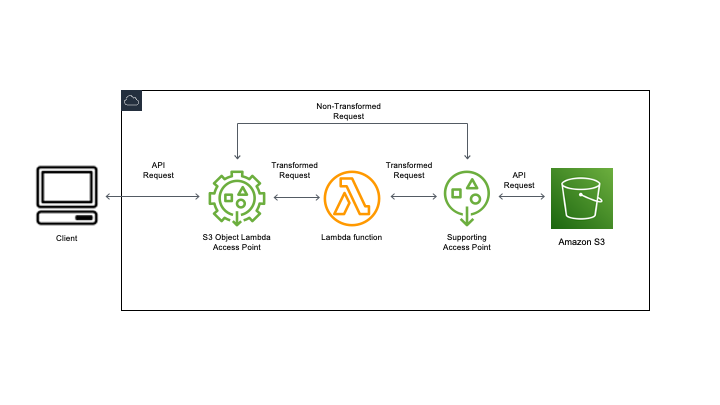Transforming objects with S3 Object Lambda
With Amazon S3 Object Lambda, you can add your own code to Amazon S3 GET, LIST,
and HEAD requests to modify and process data as it is returned to an
application. You can use custom code to modify the data returned by S3 GET
requests to filter rows, dynamically resize and watermark images, redact confidential data,
and more. You can also use S3 Object Lambda to modify the output of S3 LIST requests to
create a custom view of all objects in a bucket and S3 HEAD requests to modify
object metadata such as object name and size. You can use S3 Object Lambda as an origin for your
Amazon CloudFront distribution to tailor data for end users, such as automatically resizing images,
transcoding older formats (like from JPEG to WebP), or stripping metadata. For more information, see the
AWS Blog post
Use Amazon S3 Object Lambda with Amazon CloudFront
How S3 Object Lambda works
S3 Object Lambda uses AWS Lambda functions to automatically process the output of standard S3
GET, LIST, or HEAD requests. AWS Lambda is a
serverless compute service that runs customer-defined code without requiring management
of underlying compute resources. You can author and run your own custom Lambda functions,
tailoring the data transformation to your specific use cases.
After you configure a Lambda function, you attach it to an S3 Object Lambda service endpoint, known as an Object Lambda Access Point. The Object Lambda Access Point uses a standard S3 access point, known as a supporting access point, to access Amazon S3.
When you send a request to your Object Lambda Access Point, Amazon S3 automatically calls your Lambda function. Any
data retrieved by using an S3 GET, LIST, or HEAD
request through the Object Lambda Access Point returns a transformed result back to the application. All other
requests are processed as normal, as illustrated in the following diagram.

The topics in this section describe how to work with S3 Object Lambda.
Topics
- Creating Object Lambda Access Points
- Using Amazon S3 Object Lambda Access Points
- Security considerations for S3 Object Lambda Access Points
- Writing Lambda functions for S3 Object Lambda Access Points
- Using AWS built Lambda functions
- Best practices and guidelines for S3 Object Lambda
- S3 Object Lambda tutorials
- Debugging and troubleshooting S3 Object Lambda
For S3 Object Lambda tutorials, see the following:
For more information about standard access points, see Managing access to shared datasets with access points.
For information about working with buckets, see Buckets overview. For information about working with objects, see Amazon S3 objects overview.